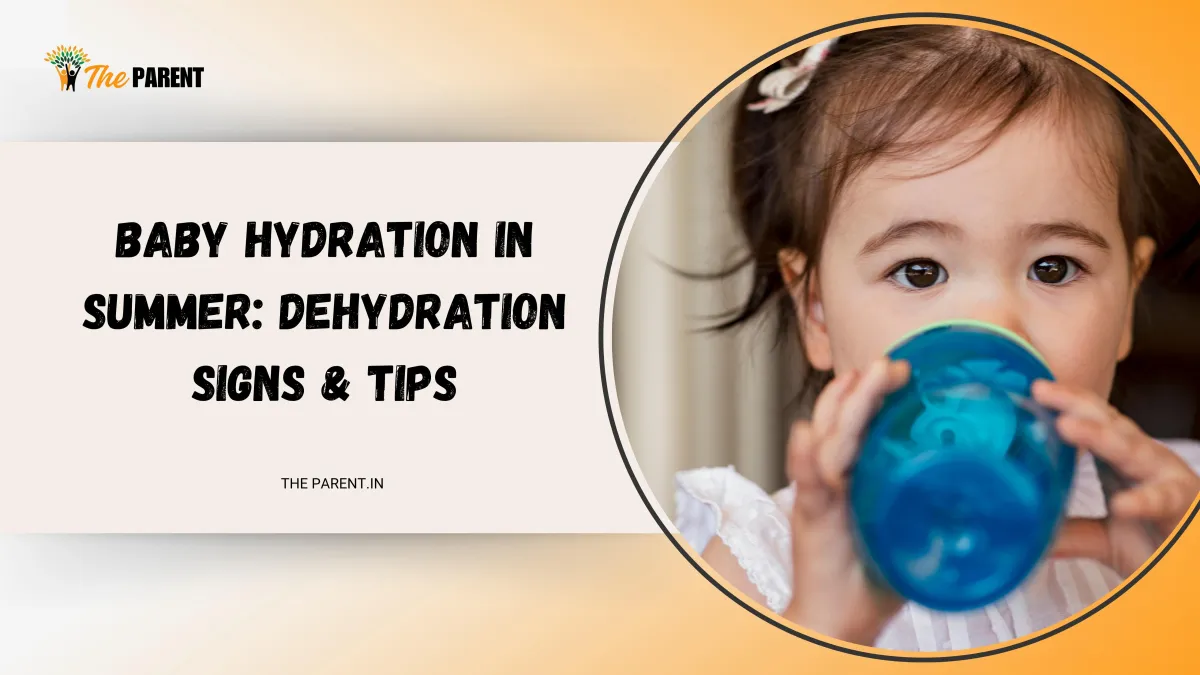
Baby Hydration in Summer: Dehydration Signs & Tips
Summer usually brings sunshine, outdoor adventures, and warmer weather, but it also brings complications, for example, keeping your infant hydrated. In hot weather, dehydration can occur quickly for infants as they can lose fluids more quickly than adults (due to their little bodies)! As parents, it can be difficult to prioritize feeling well and keeping your little one comfortable in the summer! It's important to note dehydration signs and implement safe ways to hydrate in hopes of having a better summer with your little one.
Also Read 👉Teach Kids to Say NO to Bad Influences & Trends
We’ll look at how and why baby hydration is important during the summer months, visit a few signs of dehydration to look out for, and give you strategies to help prevent dehydration with safe drinks and feeding practice. You will be armed with tips and pandemic-people-research based suggestions so you can feel confident keeping your baby safe and hydrated with the real-world examples in mind. Let’s jump in!
Why baby hydration is important in summer
Babies have very sensitive systems that can't control temperature or how much fluid they lose as efficiently as adults. Because babies have a higher surface-area-to-body-weight ratio, they naturally lose water quickly through sweat, more so when placed in hot and humid conditions. The AAP states that infants (< 6 months) are at a greater risk of dehydration, as they metabolically are relying 100% on breastmilk or formula.

Dehydration in babies can lead to serious issues like lethargy, irritability, or even heatstroke if not addressed. A 2023 study by the Journal of Pediatric Health Care noted that dehydration-related hospital visits for infants spike by 15% during summer months. Understanding how to keep your baby hydrated is crucial for their safety and well-being.
Signs of Dehydration in Babies
Spotting dehydration early can prevent serious complications. Here are key signs to watch for, especially during summer:

1. Fewer Wet Diapers
Babies should have at least 6-8 wet diapers daily. Fewer wet diapers or dark, concentrated urine can signal dehydration.
Real-World Example: Sarah, a new mom, noticed her 4-month-old had only three wet diapers one hot July day. After consulting her pediatrician and increasing feedings, she restored her baby’s hydration levels.
2. Dry Mouth or Lips
Check your baby’s mouth for dryness or cracked lips. A sticky tongue or lack of saliva is a red flag.
3. Sunken Fontanelle
The soft spot on a baby’s head may appear sunken if they’re dehydrated. This is a serious sign requiring immediate attention.
4. Lethargy or Irritability
A dehydrated baby may seem unusually tired, fussy, or unresponsive. If your normally active baby is sluggish, check for other symptoms.
5. No Tears When Crying
If your baby cries without tears, it’s a strong indicator of dehydration, as their body lacks enough fluid to produce them.
Pro Tip: If you notice these signs, offer fluids immediately and contact a pediatrician, especially for infants under six months. Severe dehydration may require medical intervention.
Prevention Tips for Keeping Your Baby Hydrated
Preventing dehydration is easier than treating it. Here are practical, safe strategies to ensure your baby stays hydrated in summer, focusing on appropriate drinks and feeding practices.

1. Prioritize Breast Milk or Formula
For babies under six months, breast milk or formula is the gold standard for hydration. Both provide the perfect balance of water, nutrients, and electrolytes. The aap recommends exclusive breastfeeding or formula feeding for the first six months, even in hot weather.
Real-World Example: Maria, a mom in Texas, worried her breastfed 3-month-old wasn’t getting enough fluids during a heatwave. Her pediatrician advised offering small, frequent feedings (every 2-3 hours) to keep her baby hydrated, which worked perfectly.
2. Introduce Water for Older Babies
For babies over six months, small amounts of water (2-4 ounces daily) can supplement breast milk or formula, especially in summer. Use a sippy cup or bottle and avoid sugary drinks like juice, which can upset their stomach.
Pro Tip: Always check with your pediatrician before introducing water to ensure it’s appropriate for your baby’s age and needs.
3. Offer Frequent Feedings
In hot weather, increase the frequency of feedings to compensate for fluid loss. For breastfed babies, nurse on demand—often every 1-2 hours. For formula-fed babies, stick to their usual formula but offer smaller, more frequent bottles.
4. Dress for Comfort
Dress your baby in lightweight, breathable clothing like cotton onesies to prevent overheating. Avoid heavy layers or swaddling in high temperatures, as overheating can increase fluid loss.
Real-World Example: During a summer picnic, James noticed his 8-month-old was fussy and sweaty in a thick outfit. Switching to a loose cotton romper and offering extra formula kept his baby comfortable and hydrated.
5. Monitor Outdoor Time
Limit outdoor activities during the hottest parts of the day (10 AM to 4 PM). Seek shade, use a stroller canopy, or stay indoors with a fan or air conditioning to keep your baby cool. The CDC notes that babies are at higher risk for heat-related illnesses, so keeping them cool reduces dehydration risks.
6. Use Electrolyte Solutions (If Advised)
For babies over six months showing mild dehydration (e.g., after diarrhea or vomiting), a pediatrician may recommend an oral rehydration solution like Pedialyte. Never give these without medical guidance, as they’re designed for specific situations.
7. Watch for Heatstroke Risks
Dehydration can escalate to heatstroke in extreme heat. Symptoms include high fever, rapid breathing, or unconsciousness. If you suspect heatstroke, seek emergency care immediately.
Common Mistakes to Avoid
When it comes to baby hydration, well-meaning parents can make mistakes. Here’s what to steer clear of:
Giving Water to Babies Under Six Months: Plain water can disrupt their electrolyte balance and cause serious health issues.
Overloading on Sugary Drinks: Juice or sweetened beverages can cause diarrhea, worsening dehydration.
Ignoring Symptoms: Delaying action on dehydration signs can lead to complications. Always act quickly.
Overheating Indoors: Keeping your home too warm can dehydrate your baby. Aim for a comfortable 68-72°F.
Real-World Example: A first-time dad gave his 5-month-old water to “cool her down” during a hot day, unaware it could harm her. After a pediatrician explained the risks, he switched to frequent breastfeeding, keeping his baby safe.
Why Safe Hydration Practices Matter

Keeping your baby hydrated in summer isn’t just about comfort—it’s about health and development. Proper hydration supports their growth, digestion, and temperature regulation. A 2024 study in Pediatrics found that even mild dehydration in infants can affect cognitive function and mood, underscoring the need for vigilance.
By using safe drinks like breast milk or formula and following smart feeding practices, you’re giving your baby the best chance to thrive. Plus, you’ll have peace of mind knowing you’re prepared for summer’s challenges.
Keep Your Baby Happy and Hydrated
Summer is a wonderful time for making memories with your little one, but it demands extra care to keep them hydrated. By recognizing dehydration signs and using safe hydration practices like frequent feedings and appropriate drinks, you can ensure your baby stays healthy and comfortable. Start by checking their diapers, dressing them lightly, and consulting your pediatrician if you’re unsure.
What’s your go-to tip for keeping your baby cool in summer? Share your thoughts in the comments—I’d love to hear how you’re navigating the heat with your little one!


